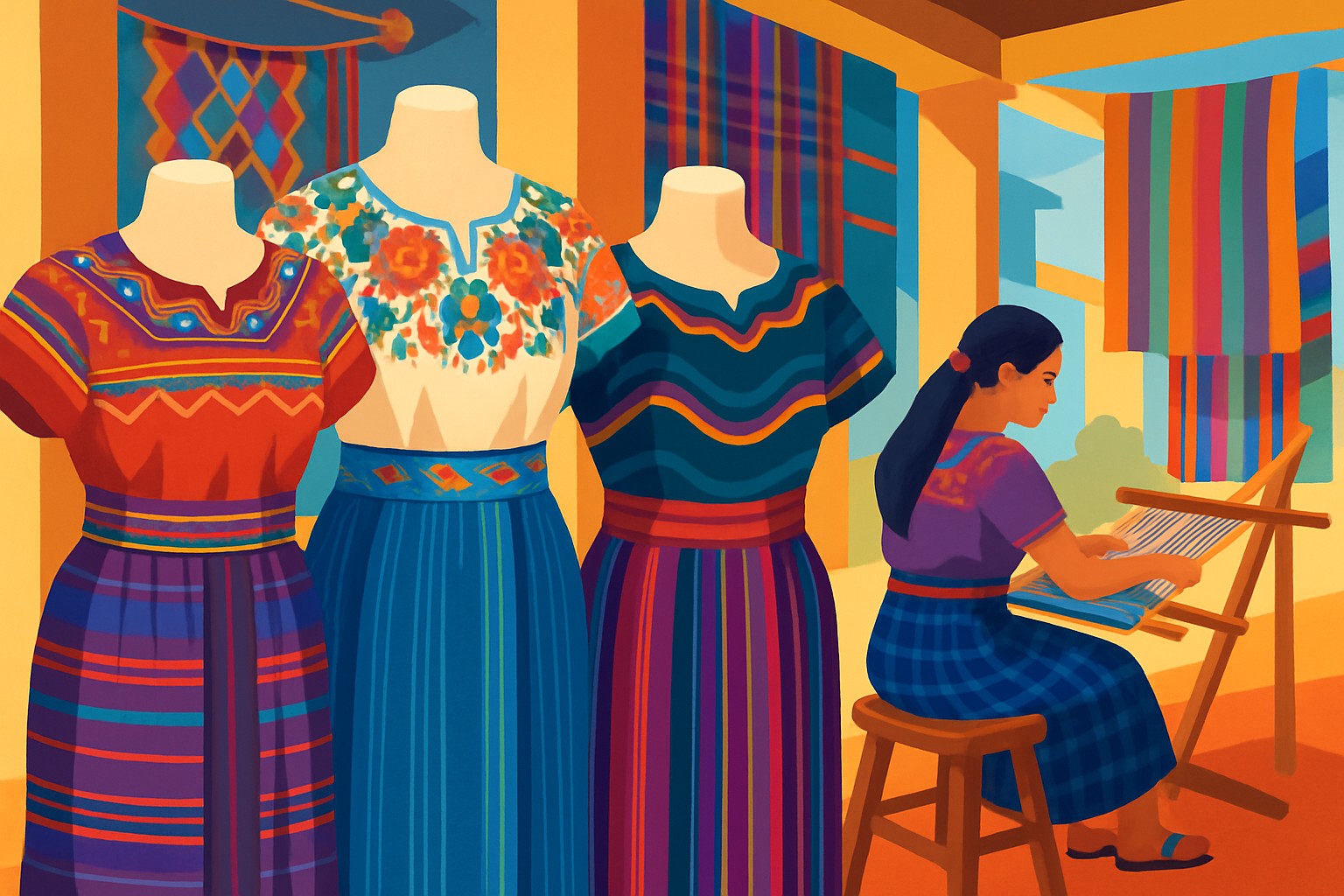Traditional Guatemalan Clothing - Materials And Techniques

Traditional Guatemalan clothing is a lively tapestry that weaves together culture and history with identity in a truly unique way. This article takes a closer look behind the scenes at the materials and techniques used to craft these garments. It paints a vivid picture of their deep meaning and intricate craftsmanship.
Taking a Closer Look at Traditional Guatemalan Clothing
Traditional Guatemalan clothing showcases distinctive garments that capture the spirit of its diverse indigenous communities. The key pieces include the huipil, a beautifully embroidered blouse; the corte, a woven skirt rich with meaningful patterns; and the faja, a belt that ties everything together. These items are worn with pride in daily life and during special ceremonies.
- Huipil: A handwoven blouse embroidered with designs unique to each community that carry rich symbolic meaning and tell a story.
- Corte: A colorful wrap-around skirt made from cotton or wool that features traditional patterns.
- Faja: A wide belt that holds the corte snugly and showcases vivid geometric designs adding personality.
- Camisa: A shirt usually worn under huipils, plain or with light embroidery for interest.
- Tilma: A woven cloak or shawl used for warmth or special ceremonies that blends practicality with cultural flair.
Common Materials Found in Traditional Guatemalan Clothing
When it comes to traditional Guatemalan attire, the materials used truly tell a story—woven with history and bursting with culture. You will often find vibrant fabrics crafted from cotton and wool, each thread carefully chosen for its feel and durability. These are not just clothes; they are a tapestry of heritage, lovingly passed down through generations. And do not be surprised if you spot a hint of silk here and there, adding a touch of subtle luxury to the everyday wear. In my experience, it is the blend of these materials that gives each garment its unique character—comfort meets tradition, with just the right splash of flair.
Artisans carefully pick natural fibers and dyes when crafting traditional Guatemalan garments while keeping durability, comfort and cultural significance front and center. Cotton and wool provide breathable yet sturdy foundations. The dyes sourced from plants and even insects bring out rich colors that mean much more than meets the eye.
- Cotton usually feels soft and breathable and is easy to dye. That is why it is the go-to fabric for many traditional garments.
- Wool, gathered from local sheep, delivers cozy warmth. It is a staple especially in chillier highland communities.
- Indigo is a deep rich blue dye pulled from the indigo plant and prized for its eye-catching color.
- Cochineal, a red dye made from the cochineal insect, brings out vivid crimson hues that pop.
- Annatto, derived from seeds, paints warm shades between orange and red.
- You’ll spot metallic threads, beads and feathers tossed in not just for flair but to carry serious symbolic weight.
| Material | Source | Characteristics | Cultural Significance |
|---|---|---|---|
| Cotton | Locally grown cotton plants | Light, breathable, and soft | Often seen as a humble yet profound symbol of our bond with the earth and the rhythms of everyday life |
| Wool | Highland sheep | Warm, coarse, and sturdy | Commonly stands for resilience and a trusty shield against the chilly winds of life |
| Indigo Dye | Indigofera plant | Rich deep blue color | Traditionally tied to spirituality and fertility, carrying a kind of mystical allure |
| Cochineal Dye | Cochineal insect | Bright, vivid red | Bursting with life and vitality, it’s a favorite in rituals that celebrate the spark of existence |
| Annatto Dye | Seeds from achiote tree | Shades from bright orange to red | Infuses warmth and energy, like a little sunshine you can wear |
| Metallic Threads | Imported or local metal | Shiny, reflective highlights | Usually reserved to show off status and add a touch of ceremony—because who doesn’t like a bit of sparkle? |
Essential Techniques for Making Traditional Clothing
When it comes to crafting traditional clothing, there are a few key techniques that make all the difference. These time-honored methods have been passed down through generations, and once you get the hang of them, you will see why they have stood the test of time. Whether you are a seasoned seamstress or just dipping your toes into the world of fabric and thread, mastering these basics can turn a good project into something truly special.
Traditional Guatemalan clothing showcases the expert weaving and embroidery skills lovingly handed down through generations. These age-old techniques transform humble raw fibers into striking textiles, where the steady beat of the loom and delicate hand stitching blend seamlessly to create practical art bursting with deep cultural meaning.
Weaving on a Backstrap Loom A Time-Honored Craft with a Personal Touch
The backstrap loom is a simple yet surprisingly versatile weaving tool cherished by Guatemalan artisans. It consists of a handful of wooden rods and strings, with one end anchored to a fixed point and the other cleverly hooked to the weaver by a strap wrapped around their back. This clever setup allows the weaver to tweak the tension just by shifting their body.
Embroidery and Its Rich Symbolism
Embroidery adds a touch of intricate charm and rich symbolism to traditional garments. Skilled artisans weave motifs that often spin stories or echo the spirit of their communities, all through techniques lovingly passed down over generations. Each pattern carries its own weight of meaning, whether inspired by the natural world or age-old myths.
- Common motifs often highlight animals like birds and jaguars along with plants such as maize and flowers. Geometric shapes beautifully represent the cosmos. These elements tell a story.
- Colors usually carry strong meanings. For example, red almost always represents life or blood while green is often associated with fertility. Each hue has its own unique personality.
- Hand embroidery remains the preferred technique. The stitches not only decorate but also add texture and a lovely sense of depth to the fabric.
- Satin stitch is the reliable choice for creating smooth filled areas within patterns giving them a sleek and polished appearance.
- Cross stitch contributes delicate, intricate details that add complexity especially to geometric designs. These small touches really catch your eye.
- Occasionally beads and metallic threads make an appearance to enhance the embroidery’s richness and add even more symbolic meaning as if dressing it up for a special occasion.

How Traditional Clothing Gently Weaves Its Way Through Guatemalan Culture
Traditional clothing in Guatemala is not just fabric. It’s a vivid tapestry of ethnic identity and community pride that weaves the past and present in a colorful dance. Each piece reveals where the wearer comes from and hints at their social standing or marital status. People wear these garments with genuine pride during festivals and religious celebrations or life milestones. Far beyond decoration, these clothes carry stories of heritage, hardship and resilience.
“Each thread we weave feels like it carries a little piece of our ancestors' soul. Wearing traditional clothing isn’t just about looking beautiful—it’s a heartfelt way to keep our history and identity alive for the generations that follow.” — María López, Guatemalan Textile Artisan
Many people often assume that traditional Guatemalan clothing is a one-size-fits-all deal for all indigenous groups or something dusty reserved for special occasions only. In reality, designs and styles vary quite a bit from region to region and each echoes the unique local heritage and climate. Many indigenous people wear these clothes daily, mixing their rich cultural identity with modern life rather than saving them for ceremonies.
Current Challenges and the Ongoing Efforts to Keep Things Afloat
Globalization and the surge of synthetic textiles have thrown a wrench into the works for traditional Guatemalan clothing to flourish. Many young individuals are squeezed by economic pressures and often opt for cheaper mass-produced garments. This is a real threat to those age-old skills. Cooperative initiatives, fair trade groups and cultural education programs are stepping up in a big way. They play a vital role in keeping artisans’ crafts alive and well.
- Traditional weaving skills are slowly slipping through the cracks, as fewer young people learn the ropes straight from their elders.
- Mass-produced textiles have flooded the market, often undercutting those lovingly handmade artisan garments by a mile.
- Economic pressures are nudging many artisans to explore other avenues for making ends meet.
- Artisan cooperatives step in with collective bargaining power and a helping hand to share resources.
- Fair trade organizations are on the front lines, fighting for fair wages and championing ethical supply chains.
- Cultural programs play a vital role in passing down the love for heritage textiles, making sure the younger generation understands their true value.
Creative Ways to Show Love and Support for Traditional Guatemalan Clothing
Supporting Guatemalan textile traditions starts with a genuine appreciation for their rich cultural heritage and choosing traditional Guatemalan clothing that is truly handmade. When you choose ethically sourced textiles you are not just buying a product; you are helping to keep artisan livelihoods afloat and celebrating a deep sense of cultural pride.
Take a little extra time to really dive into the stories and meanings woven into each design and the communities they come from. This makes all the difference in your appreciation.
Whenever possible, buy textiles and clothing directly from genuine Guatemalan artisans or reliable fair trade sellers because it is the best way to support the craft and feel that authentic connection.
Remember to honor the deep cultural significance of traditional garments. This helps you avoid cultural appropriation and show genuine respect.
If you’re lucky enough to join cultural events or festivals, do your best to be mindful and follow local customs and traditions as it shows you truly care.
Spread the word by sharing what you learn about traditional weaving techniques and their rich symbolism. Helping others appreciate this heritage can be truly rewarding.
Questions & Answers
What makes traditional Guatemalan clothing unique compared to other indigenous textiles?
Traditional Guatemalan clothing stands out thanks to its vibrant community-specific patterns and time-honored handwoven techniques like backstrap loom weaving. Each garment is like a walking storybook bearing the wearer’s village, identity and culture in colors and symbols that carry rich meaning. Unlike cookie-cutter fabrics churned out in factories, these pieces are living art—functional, beautiful and a bridge to centuries-old traditions.
Can I wear traditional Guatemalan clothing if I’m not from the indigenous communities?
Absolutely appreciating these beautiful garments is encouraged but it’s vital to dodge cultural appropriation. The golden rule is to buy ethically from artisans, grasp the cultural significance of what you’re wearing and rock these pieces respectfully—maybe as shawls or accessories—without passing them off as your own heritage. Supporting the artisans financially while honoring their traditions is the best way to show you care.
How can I identify authentic handmade Guatemalan textiles?
Authenticity often shines through charming little imperfections that only come from handcrafting, natural fibers like cotton or wool and traditional regional motifs that tell a story. The safest bet is to buy from cooperatives or fair-trade sellers who can vouch for the artisan’s roots. Mass-produced knockoffs usually use synthetic materials and miss the detailed handiwork that genuine textiles proudly display.
Why are some traditional Guatemalan garments so expensive?
Handwoven textiles are a labor of love that sometimes take weeks or even months from spinning the yarn to dyeing and embroidery to create. Fair prices reflect the immense skill and time artisans pour into each piece rather than the bargain-basement costs of cheap imitations. When you buy authentic garments, you’re not just scoring a unique item—you’re helping keep a vibrant cultural heritage alive and putting sustainable income into the hands of weaving communities.
How can I help preserve traditional Guatemalan weaving techniques?
There are plenty of meaningful ways to pitch in: support artisan cooperatives, chip in to cultural education programs or share their inspiring stories online. Buying directly from weavers, joining workshops and backing fair trade policies are hands-on steps that help ensure these treasured traditions don’t fade away but keep thriving for generations to come.
Are there modern adaptations of traditional Guatemalan clothing?
You bet. Many artisans are getting creative by blending traditional methods with fresh contemporary styles—think huipil-inspired dresses or woven bags that are both trendy and steeped in heritage. These modern twists keep the craft alive and kicking, showing that tradition can be anything but stuck in the past. Keep an eye out for collaborations between designers and indigenous communities to find thoughtfully made ethical pieces that honor their roots.





